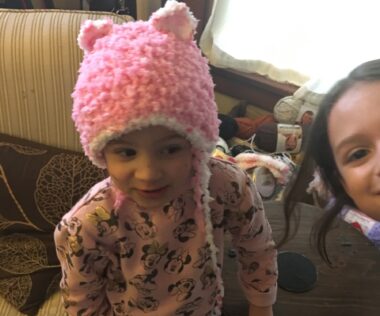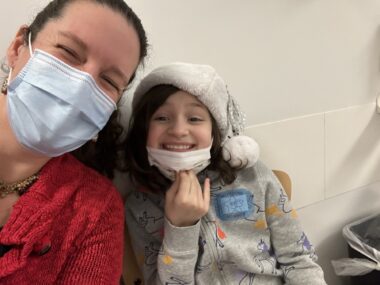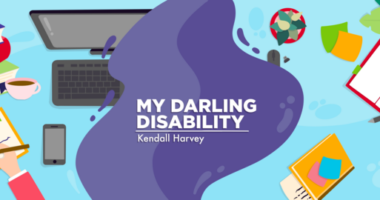My daughter with FA dreams about reversing her disease progression
Children with Friedreich's ataxia need an approved treatment, too

A nearby candle slowly cloaked the room in the scent of a Christmas tree while my 11-year-old daughter, Amelia, and I sloshed through her homework. My phone lit up with a new memory notification, capturing Amelia’s attention. If you’re unfamiliar with this feature, it pulls photos or videos from a previous date or place and slides them across the screen for a stroll down memory lane.

Katherine, left, and Amelia sit with Santa in Columbus, Ohio, on Dec. 3, 2018. (Photo by Elizabeth Hamilton)
Having knocked out her math, I bent to the voice begging to see the photos. Like most children, Amelia and our older daughter, Katherine, love seeing videos and baby photos of themselves. Play was pressed and the music swelled as videos of dancing, singing, and giggling sisters pulled us in. The sweet memories were accompanied by a gut punch as Amelia softly uttered, “Wow, I used to be really good at doing things I can’t do now.”
Over the past five years, Amelia has lost an incredible number of abilities. She’s hit developmental milestones in reverse as Friedreich’s ataxia (FA) works to destroy the dancing little girl in the videos.
When we were on our diagnostic journey, we heard the same comment from medical experts across many fields: “Whatever this is, it’s moving quickly and aggressively.” While FA can progress at various rates and affect individuals in different ways, it showed up for our child with a determination to steal her health at a rapid and terrifying pace.

On Nov. 20, 2017, Amelia wears the kitty hat she requested her mom make for hospital visits while her sister, Katherine, sneaks in the photo. (Photo by Elizabeth Hamilton)
After meeting parents in our FA community with young children, I realized that our experience is not unique. Many face the swift declines, life-threatening medical conditions, and independence gone before it was ever attained.
As we enter the holiday season, we assess the needed changes to our family traditions. There will be no marching into the woods to cut a tree. Hot chocolate must now be consumed carefully with a straw. As we gather to decorate, we hold our breath, hoping Amelia can still share in the simple act of hanging an ornament. We know she’ll need help.
A case for children
Amelia’s FA diagnosis came with some mental and emotional relief. Undiagnosed diseases are nearly impossible to treat. After three and a half years of the unknown, we had a name, available research, an incredible community, and the strategic leadership of the Friedreich’s Ataxia Research Alliance.
As we learned more, family and friends pointed out active individuals with FA in their 30s and 40s as an offering of hope. My internal dialogue responded that the age of onset and number of GAA repeats told us our situation wasn’t theirs. Amelia’s version was moving faster. Despite knowing this, I held a stoic smile. Sometimes the truth is too hard to pass through the lips that have kissed my baby’s head thousands of times and whispered promises of protection that I’m no longer able to keep.
The magic blue pill
This year brought about a huge change in our community: the first treatment for FA approved in the U.S.! The news came while I was at a speaking engagement, and I excused myself to cry in the bathroom. I shed tears of relief for my friends who would gain access to this medication and of pain for those in the global community who are still waiting. I knew insurance would be a struggle, but we were gaining ground in the fight for survival.
Because the medication is approved only for FA patients ages 16 and older, I didn’t think twice about my child other than the treasured idea that her future was brighter. In my mind, surely an expedited approval for the vulnerable pediatric population would soon follow. The lifeboat is available; children should have a place in it.

Amelia wears a silver Santa hat while waiting with her mom at one of her many medical appointments on Dec. 12, 2022. (Photo by Elizabeth Hamilton)
Nine months later, we’re still waiting for that journey to begin. In the interim, our youngest population is losing valuable skills, abilities, and sometimes lives. It feels like drowning within an inch of the water’s surface. My hope recalibrates to the reality of the uphill climb of the mountain before us.
The dreams of my daughter
Sometimes Amelia wakes up and tells me about her dreams in her innocent, sleepy voice. More recently, her summaries are fantastical, but not because they contain dancing sugarplums. Instead, she’s able to travel down the stairs without assistance, jump off the bottom step, and not fall when she lands. She describes this adventure in detail and how freeing it feels.
As she talks, I work to provide support in our conversation under the glow of the lovingly displayed pink Christmas tree in her room. I feel her delicate hand with beautifully shaped fingers curl around mine, just as they did when she took her first steps, and will continue to do as she struggles to maintain her balance.
Note: Friedreich’s Ataxia News is strictly a news and information website about the disease. It does not provide medical advice, diagnosis, or treatment. This content is not intended to be a substitute for professional medical advice, diagnosis, or treatment. Always seek the advice of your physician or another qualified health provider with any questions you may have regarding a medical condition. Never disregard professional medical advice or delay in seeking it because of something you have read on this website. The opinions expressed in this column are not those of Friedreich’s Ataxia News or its parent company, Bionews, and are intended to spark discussion about issues pertaining to Friedreich’s ataxia.









Leave a comment
Fill in the required fields to post. Your email address will not be published.